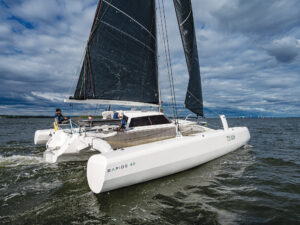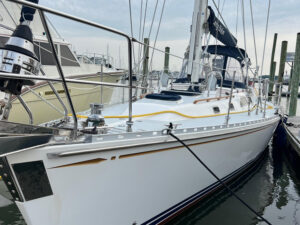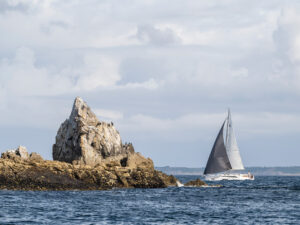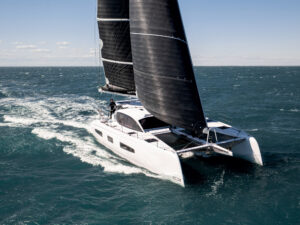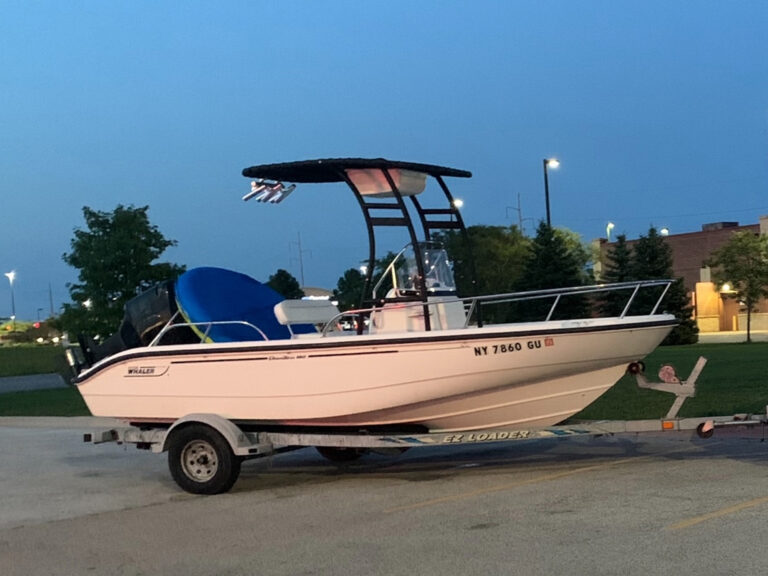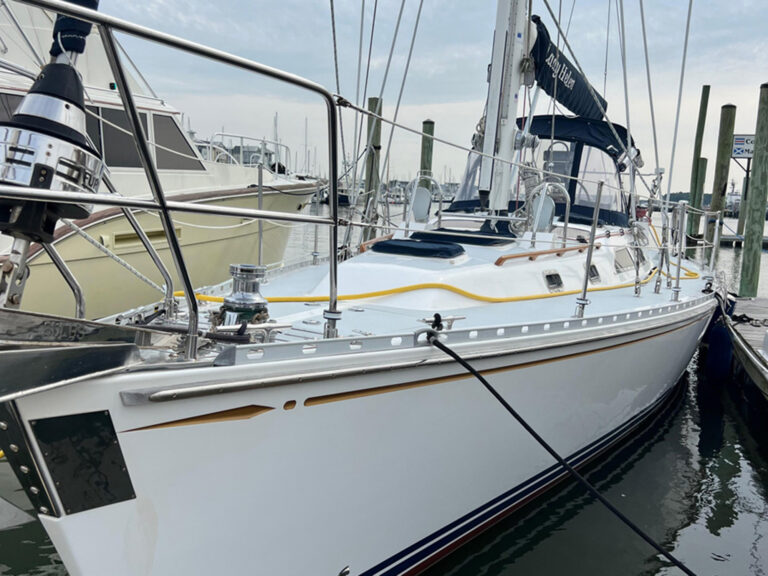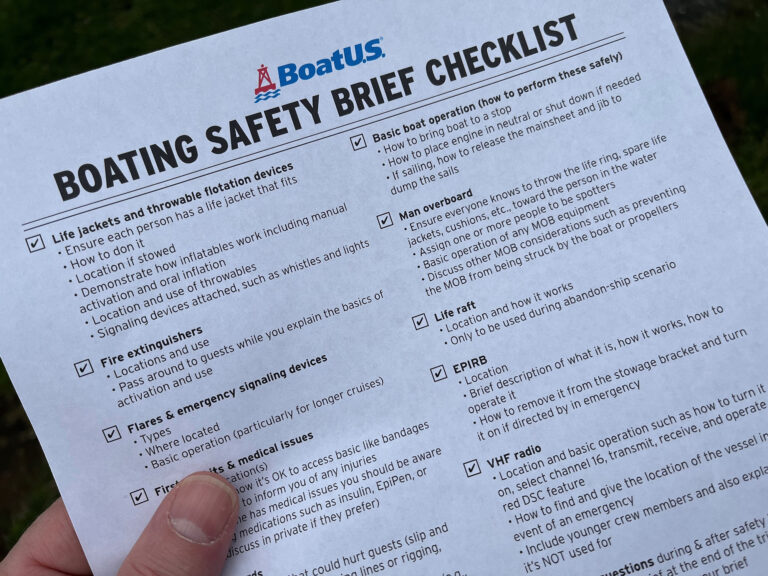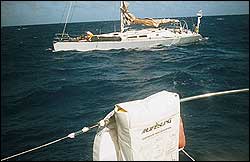
Mark, my “chief of the boat,” first spotted the odd-looking sailboat. It was June 2002, and we were motoring through a flat calm sea aboard my 48-foot aluminum cutter, Simba, two days into the return passage to Connecticut after a frustrating race to Bermuda.
Through the binoculars we could see she was riding low at the bow and her mainsail was dumped carelessly over the boom. I hailed her several times on VHF Channel 16. Nothing. Over 420 miles from the Long Island Sound and 200 miles from Bermuda, we dropped the sails and powered over to investigate.
The name on the transom read Caliente.
“Ahoy, Caliente!” we called. Still nothing. She was low in the water, disheveled, lifeless. “Ahoy, Caliente!” I shut the engine down and listened. “Ahoy, Caliente!” She was gurgling with water sloshing over her sole. With our imaginations working overtime, Simba’s crew was nervous, excited, and focused on the strange scene.
Including Mark and myself, there were seven of us on board Simba. My oldest son, Chris, was joined by two of his friends, Nick and Tyler; all three had just graduated from high school. Jeff, who was on his second Bermuda-to-Connecticut passage with me, and Tyler’s father, Brian, the cook, rounded out our crew.
As we approached for a closer look, we imagined bodies and bullet holes or a trap set by pirates. A bridle of 1-inch rode hung over the bow, suggesting that a sea anchor had been set in a storm. Something had gone terribly wrong.
Mark, the first to board, found 6 to 8 inches of putrid water above the sole and general chaos in the cabin. Clothing, food, blankets, sleeping bags, cushions, and books were adrift in a foul sludge. No one was on board. We tied Simba off the stern as Brian, Chris, Nick, and Mark went to work. Using Simba’s portable manual bilge pumps and a long wire from Simba’s batteries to power Caliente’s electric bilge pumps, they eventually got the water flowing.
Caliente slowly rose to her old waterline while Mark started to inventory the systems: The engine and electrical system were dead. The steering quadrant was broken. The mainsail had several tears, and the life raft was missing. But she was salvageable, and with enough men for the job, we decided to try.
We couldn’t go anywhere without rudder control, so Mark rigged the emergency tiller while Chris and Brian hauled in the rode hanging from the bow. They collected about 400 feet of barnacle-caked line and cut it off to serve as a towline. Three and a half hours into our effort, as the sun’s last light lingered, we collected our crew and began our journey north.
A Father’s Decision In the wee hours of the next morning, I was standing at Simba’s helm. Like a ghost, Caliente was following in tow 100 yards astern. The breeze had picked up to 10 knots. Motorsailing under the main and genoa doubled our speed to 4.5 knots. It was time to cut our tether and set Caliente off with her own crew.
I decided that Mark and Chris, my son, would take Caliente. Three crew would be better, but I saw no other option. Nick was out; at his graduation, I’d made a promise to his mother to look after him. I couldn’t break up Tyler and his father, and I wanted Jeff on Simba for his sober, conservative judgment.
Mark was an obvious choice: He was a born problem solver. But my decision to send Chris off on a disabled boat made me uneasy. Once the crews separated, there was no guarantee that we’d be able to help them. Still, Chris was 18 years old. I’d just have to trust in his ability to take care of himself.
Caliente looked to be about 50 feet long and designed explicitly for racing. Sleek and well equipped, she was clearly meant to sail. If the main was serviceable, I knew we could get her to safe harbor. Jeff and Brian pulled together a list of necessities for the salvage crew: food, water, handheld VHF radios, EPIRB, flashlights, battery-powered floodlights, strobes, glow sticks, harnesses, life vests, knives, tools, shackles, tape, sail-repair kit, foulies, sleeping bags, warm clothing, and so on.
First light brought a gray sky, 18- to 20-knot winds, and an erratic, sloppy sea. Caliente was rolling. I was apprehensive about the transfer, but we were committed to trying. Chris and Mark were quiet and nervous. Backpack on, Mark tumbled into the cockpit on the first pass. On the next pass, a wave slammed Caliente’s rig into Simba’s shrouds. The near collision shook our confidence, but Chris made it aboard. Nick tossed over a messenger, and Chris hauled in the waterproof duffel full of supplies.
While Chris and Mark were busy fixing tears with sticky-back Dacron and assessing the sail inventory, we sailed in circles around Caliente. About three hours after the two transferred to Caliente, they spun her onto port tack. Heading 345 degrees under a double-reefed mainsail, she began her long gallop to the U.S. coast. The emergency tiller was too short for the powerful sail plan, so Chris and Mark, who’d careened out of control when the main first went up, rigged a steering line from the tiller to the primary winches. The wind was approaching 25 knots.
Gradually, the wind started to head us, making it difficult for Caliente to lay a direct course without a headsail. Chris wrestled a small jib onto the deck, and bit by bit, as waves pummeled him on the pitching bow, he raised the sail, repairing the damaged luff tape as he went. Under a double-reefed main and the small jib, Caliente immediately leaped into life, rocketing ahead of Simba. Chris and Mark made some sail adjustments, and soon enough we were both well balanced and screaming up the course.
Night Watch In all the excitement, the challenge of the first night watch hadn’t really occurred to us. Caliente’s crew agreed to put a floodlight on her sails every half hour, but they would leave the handheld VHF radio off to conserve batteries. On Simba, Jeff, Brian, and I stood three-hour watches, while Tyler and Nick rested in the cockpit on standby. When my 2200 watch came up, I’d had only a few brief moments of shuteye in 36 hours. My eyes strained to stay open, and I began to hallucinate. We were sailing close to the 25-knot wind, so the ride on Simba was loud and lumpy.
Caliente was ahead and to leeward, but when I looked straight at her, she seemed to disappear. I learned to track her in my peripheral vision, and I constantly shook my head to stay alert. Nick was in the cockpit, but he was asleep and seasick. When Jeff came up for his watch, it wasn’t a moment too soon. I passed the helm to him with barely a word and dove for a midship bunk. I’d been awake for 40 hours straight.
It seemed as if only a short time had passed when a sudden anxiety brought me back to the cockpit. Nick was awake, somewhat seasick, and peering through the binoculars. Jeff was extremely concerned. We’d lost contact with Chris and Mark. As the visibility got worse and the sea grew surly, our simple communication system had failed.
Arriving for their watch, Brian and Tyler brought up the night scope. In the darkest hour before dawn, as the clocking wind pushed us on a new course east of Newfoundland, the five of us began an all-horizon search for Chris, Mark, and Caliente.
Happily, Nick and Tyler spotted Caliente as a floodlight illuminated her mainsail, right on schedule. She was more than a mile to windward, while we’d believed she was to leeward. During the night, the wind had headed us by 40 degrees, and Caliente, faster and able to sail closer to the wind, had climbed away from us. Keeping two very different boats together for the next 360 miles clearly wasn’t going to be easy.
“What if we hit fog near the shipping lanes?” Jeff pointed out. “We need a plan in case we get separated. We need two-way communication.” By midmorning, we’d gradually closed the gap on Caliente, and through the binoculars I watched Chris sitting at the helm. He was tan, healthy, and smiling, pumping a fist in the air while holding the steering rein in the other. He and Mark had managed the first night on the wild and damaged Caliente. Seeing Chris smiling restored my confidence. The coming day would undoubtedly bring more problems, but I knew that we’d solve them–one at a time. We were in the Gulf Stream in 18 knots of wind, and it was time to tack toward home. Caliente tacked, Simba followed, and I descended–finally–into sleep.
Later that day, we worked to get power to Caliente so she could run the VHF and navigation lights. We sent over a spare 12-volt gel battery from Simba, which led to the discovery that the handheld VHF wouldn’t hold a charge. Communication with Caliente would be essential as we approached the shipping lanes off the New England coast. While Mark worked on the radio problem, Jeff drew up a two-page signaling protocol using our nav lights and the floodlight on Caliente.
The wind dropped to less than 10 knots. Though Caliente slid easily through the flat water, Simba struggled. Through most of the day and part of that night, we used the motor to catch up.
By the next morning, a 12-knot southwesterly had set in, and we were reaching directly for Block Island Sound. Forecasters predicted the winds would build to 35 knots, but for the moment, all was well. Soon our VHF sang out: “Simba, Simba, Simba. This is Caliente. Over.” Mark had duct-taped five D cells together with pennies as connectors to create a battery pack for one of the handhelds. We dubbed the device the “MacGyver radio.” The repair came just in time.
Homeward Bound The steady wind built through the day. When we slipped within 200 miles of Block Island Sound, we were reaching at 6 knots. Mark reported that he’d jury-rigged a navigation light, and our confidence surged. By late afternoon, we were pushing 7 knots and hopeful that we’d outrun the gale’s stiffest sector, which was predicted to bring winds of up to 40 knots from the south. Jeff relayed the weather information to Caliente, and we advised her to reef before dark.
By 0300 the next day, the edge of the gale was pumping a welcome 25 knots from the port quarter. Simba climbed to hull speed, but Caliente toyed with us, sailing ahead three-quarters of a mile, then back to within 50 yards.
We rode this breeze into Long Island Sound and up to the fuel dock at Pilots Point Marina in Westbrook, Connecticut. Mark and Chris initiated a champagne shower over Simba’s crew in celebration. We were delirious, exhilarated, exhausted, and, most important, safe.
Steven J. Knapp lives with his wife and three teenage sons in Westport, Connecticut, where they’re members of the Saugatuk Yacht Club.

